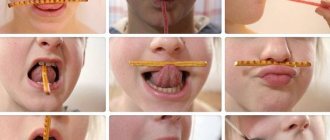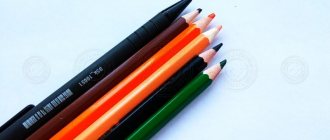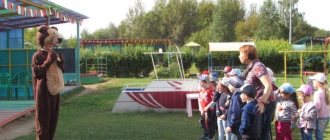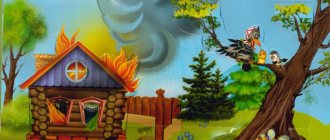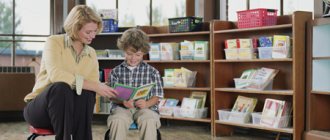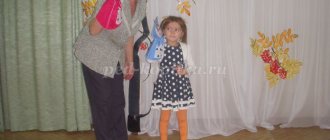Theme of the week: “Furniture”
Lesson 10. Rug for rabbits
(Brush painting. Watercolors)
Target. Teach children to decorate a rectangular object, alternating circles and lines (using a brush and watercolors); consistently use paints of two colors; independently come up with a pattern and place it over the entire surface of the object. Cultivate compassion and kindness.
Handout. A rectangular rug cut from light-colored colored paper, watercolor paints, a brush, a jar of water.
Progress of the lesson
Read V. Berestov’s poem “Bunny” to the children:
Little bunnies
They wanted some goodies,
They wanted some goodies,
Because they are small.
Ask the guys: “What did the bunnies want to do? (Bainki, go to sleep.) Where can I put the bunnies?” (In a box, on a chair, on a rug, etc.)
Place a rectangular rug cut out of light colored paper in front of each child and ask: “How can you decorate such a rug?” (Draw circles, triangles, lines, etc.)
Invite the kids to make beautiful rugs for the bunnies, decorating them with alternating multi-colored circles and lines.
At the end of the lesson, ask each child: “What kind of rug did you make? (Beautiful, elegant, colorful, affectionate, etc.) Do you think it will be nice for bunnies to sleep on such a rug?”
Theme of the week: “Dishes”
Lesson 11. Cup
(Prints made from potato stamps. Gouache)
Target. Introduce children to the technique of printing prints using potato stamps using different colors of paint. Develop speech and thinking. Practice using prepositions in speech: on, under, above, in.
Demonstration material. Utensils.
Handout. Potato signets in the form of small triangles, circles, squares; bowls filled with thin foam rubber soaked in gouache (two colors); cup template cut from paper.
Progress of the lesson
Place utensils one at a time on the table. Encourage the children to name them.
Play the game “Take and Bet”. Give the kids tasks using the prepositions on, under, above, in (“Take a large cup and put it on a chair”, “Take a green saucer and put it in the closet”, etc.). Then invite the children who have completed the task correctly to try to take turns giving independently invented tasks to each other and to you.
If there are many children present at the lesson, you can hold hands, forming a large circle - it turns out to be a frying pan. All together take one step forward - you get a saucepan. Take one more step towards the center - you get a plate, one more step - a saucer, then a cup.
Give each child a paper cup template and encourage them to decorate it. To do this, you need to take a potato stamp, dip one tip in gouache and press it against the template in several places to get a print. Then you need to take another signet and make new prints of a different color.
Ask the children: “What can you drink from your cups?” (Compote, water, juice, milk, kefir.)
"Furniture" GCD in the second junior group
Ivanova Elena Yurievna,
MADOOU Borovsky kindergarten "Zhuravushka"
GCD summary: “Development of mathematical abilities by means of non-traditional drawing in the second junior group on the topic “Furniture”
Goal: To develop children's powers of observation, elementary mathematical concepts, and holistic visual perception of the world around them.
1. Develop the ability to navigate in spatial directions (draw lines from top to bottom, left to right, use the words “on”, “in”, “behind”);
2. Develop the ability to see the general characteristics of objects (shape, color, size, material of manufacture), use the general concept of “furniture”;
3. Continue learning to draw straight lines.
During free play activities, children find a broken doll chair and table.
Children: - Elena Yuryevna!
Educator: - What happened, guys?
Children: - The furniture for the dolls is broken!
Educator: - What a pity... But we can help the dolls! And I know how! Where do you think furniture is made?
— Children's answers (at the factory)
Educator: - Guys, let's help our toys. I propose to open a furniture factory here. Close your eyes, turn around yourself - one, two, three! We became carpenters!
What pieces of furniture do you know? (children's answers). Bed, chair, table, wardrobe.
What do they sleep on? (on the bed).
Where do clothes go? (into the cupboard).
What are they sitting on? (on the chair)
What do they have lunch for? (At the table)
What is furniture made of? (from boards).
On the table for each child are prepared sheets of dots, as well as gouache and cotton swabs.
In front of the children there is a children's table and chair
Educator: What is there at the table?
Children: Legs and table top. They show.
Educator: What does the chair have?
Children: Seat, back and legs?
Educator: What do a table and a chair have in common?
Children: There are 4 legs, the seat and table top are square, and the table and chair are made of wood.
Educator: To make furniture, you need special drawings, which are called “schemes”. Can you draw? (yes) Then let's try to draw diagrams of a table and a chair...
Before us lie really smooth boards and drawings - mysterious drawings.
Educator: If you look at them carefully, you will see what it looks like: a table or a chair. what should be done?
The dots will help you read the drawing, open the drawing. Try to connect these points with a line (I show you how to do this on the sheet). The guys begin to draw and connect the lines of their drawings.
At the end of the GCD we consider what tables and chairs we got.
Cheerful music plays, the teacher and the children conduct the dance game “We are sitting on chairs.”
Educator: - What wonderful masters you are! Now we can send these drawings of chairs and tables to a furniture factory. And they will make us new furniture for the dolls! And then they will deliver it for our dolls! (put the drawings in a large envelope to send them)
- From birth to school. Basic educational program of preschool education / ed. NOT. Veraksy, T.S. Komarova, M.A. Vasilyeva. – 4th ed., revised. – M.: MOSAIKA-SYNTHESIS, 2022. – 352 pp.;
- Approximate comprehensive thematic planning for the program “From birth to school.” Second junior group / Ed. T.S. Komarova. - .: MOSAIC-SYNTHESIS, 2022. – 168 pp.;
- Complex classes according to the program “From birth to school” edited by M.A. Vasilyeva, V.V. Gerbova, T.S. Komarova. Second junior group / author-comp. T.V. Kovrigina, M.V. Kosyanenko, O.V. Pavlova. – Volgograd: Teacher, 2013. – 262 p.;
- https://www.maam.ru/detskijsad/konspekt-zanjatija-po-poznavatelnomu-razvitiyu-vo-vtoroi-mladshei-grupe-na-temu-mebel.html
“Certificate of publication in the media” Series A No. 0007630
We invite teachers of preschool education in the Tyumen region, Yamal-Nenets Autonomous Okrug and Khanty-Mansi Autonomous Okrug-Yugra to publish their teaching materials: - Pedagogical experience, original programs, teaching aids, presentations for classes, electronic games; — Personally developed notes and scenarios of educational activities, projects, master classes (including videos), forms of work with families and teachers.
Why is it profitable to publish with us?
1. “Kindergartens of the Tyumen Region” is an officially registered specialized media outlet at the federal level. EL No. FS 77 - 43321 2. The activities of the editorial office are supported by the Department of Education and Science of the Tyumen Region 3. We issue a “Certificate of Publication” in the media. 4. The document has a unique number, is entered in the register, has the original seal of the editorial office of the online publication and signature. 5. “Certificate of publication” in the media is sent to the author in both paper and electronic versions.
Source
Theme of the week: “Food”
Lesson 12. Let's treat the mouse with cheese
(Drawing with colored pencils)
Target. Teach children to draw semicircular objects with colored pencils and carefully paint over them. Enrich your speech vocabulary. Cultivate compassion and kindness.
Demonstration material. Toy mouse, small piece of cheese, cut out of yellow cardboard.
Handout. Landscape sheet with a mouse drawn on it, colored pencils.
Progress of the lesson
Invite the children to listen to the poem and guess who will come to visit them now:
The mouse crawled out of the hole,
The mouse really wants to eat.
Is there a dried crust somewhere?
Maybe there is some crust in the kitchen?
Show the children a toy mouse and play out the situation: a hungry mouse has come to visit you. Ask the mouse: “What do you like to eat?” (Cheese.)
Invite the children to draw cheese for the mouse - a yellow semi-oval with holes (circles) in it. Show how to paint over the cheese: place the strokes close to each other, without going beyond the outline of the object.
At the end of the lesson, invite the children to play the game “In which hand?” with the mouse.
The child hides a piece of cheese in one hand and clasps both hands into fists. The mouse must guess in which hand the cheese is hidden.
Theme of the week: “Visiting a fairy tale”
Lesson 13. Kolobok
(Drawing with colored pencils)
Target. Teach children to draw round objects with colored pencils and carefully paint over them. To encourage an emotional response to the fairy tale, to be involved in its telling.
Demonstration material. A large colorful box (chest), hero dolls for the fairy tale “Kolobok” (grandmother, grandfather, bun, hare, wolf, bear, fox) and one extra character (hedgehog).
Handout. Landscape sheet, colored pencils.
Progress of the lesson
Read the Russian folk tale “Kolobok” to the children in advance. At the beginning of the lesson, show them the “magic chest” with fairy tales. Take the grandfather and grandmother dolls out of the “chest” and ask the children to guess which fairy tale these heroes are from (there may be several options). In order to find out which fairy tale is hidden in the chest, take out the kolobok. The kids will immediately guess what kind of fairy tale it is. Ask, taking out the dolls - the heroes of the fairy tale, one by one from the chest: “Which other of the heroes of this fairy tale hid in my chest?” (Hare, wolf, bear, fox.) Last, take out the hedgehog and ask: “Did the hedgehog participate in this fairy tale?” (No.)
Show the children the puppet show “Kolobok”.
After the performance, invite the children to draw a kolobok so that grandma and grandpa don’t get upset. Each child can choose the right color and tell the sequence of the image: first you need to draw a circle, depict eyes, mouth and nose on it; below draw two oval legs. Show the children how to paint the kolobok: place the strokes close to each other, do not go beyond the outline.
Invite the children to draw a path along which the bun will roll home.
Tell the children: “What kind of bun did you get? (Round, yellow, cheerful.) Grandma and grandfather will be happy when the naughty bun returns to them!”
Preview:
Fine arts activities for children of the younger group.
Topic: “Furniture for Masha”
Goal: to consolidate ideas about furniture, its types and purpose;
- strengthen the ability to work with a brush;
- strengthen the ability to follow adult instructions;
- cultivate accuracy and independence in work.
Materials: illustrations depicting pieces of furniture, gouache in different colors.
Educator: Guys, today I met a girl Masha from a fairy tale. She was very upset and even cried. She was hurt by bears. What fairy tale do you think this girl is from?
Children: Fairy tale "Masha and the Bears"
Educator: Correct. What happened in the fairy tale?
Educator: I want to know what pieces of furniture you know? Let's solve the riddles.
It stands in every bedroom, and clothes lie in it. He is stately and majestic, Let’s say together - this is... (wardrobe)
The day has passed, it’s time to sleep, I’ll spread out my...(bed)
Even though I have four legs, I can’t run along the path. After all, when lunch came, everyone sat down at... (kitchen table)
Faithful friends of our table, Although they stand, they sit on them. (Chairs)
Educator: Correct. Let's help Mashenka and draw a table and chair for her so that she can have lunch. All that remains is to choose the color you will paint with.
As the teacher shows, the children draw. The images are schematic, made from lines.
Educator: Well done, guys, you are real masters. Masha is very happy, because now she has beautiful furniture.
Source
Theme of the week: “Winter”
Lesson 14. Snow-white winter
(Pokes with a hard semi-dry brush. Gouache)
Target. Teach children to poke with a hard, semi-dry brush. Develop an aesthetic perception of the winter landscape.
Demonstration material. The painting is a winter landscape.
Handout. A landscape sheet with a house, a Christmas tree, a tree drawn on a blue background; white gouache, hard brush.
Progress of the lesson
Look at the picture with the guys, which depicts a winter landscape, ask: “What time of year did the artist depict in the picture? (Winter.) Why do you think so? (Lots of snow, trees without leaves, etc.) What can you say about the snow?” (Fluffy, white, cold, soft.)
Read to the children an excerpt from I. Surikov’s poem:
White fluffy snow
Spinning in the air
And the ground is quiet
Falls, lies down...
Ask: “Where might the snow fall?” (On trees, houses, streets, roads, rivers.)
Place in front of each child a landscape sheet with a house, a Christmas tree, a tree drawn on it, and ask them to draw how the snowball painted everything white. To do this, you need to put quite a bit of white gouache on a dry brush and, holding the brush vertically, make pokes on top, placing snow on the house, trees, and ground. But first it is advisable to practice - make a few pokes on the paper with a dry brush.
Ask the guys: “What kind of snowball did you make?”
Summary of educational activities for drawing with young children on the topic “Furniture. High chair"
Daria Avdyukhina
Summary of educational activities for drawing with young children on the topic “Furniture. High chair"
Abstract of GCD on artistic and aesthetic development ( drawing )
with
young children on the topic : “
Furniture . Chair » Goals: To develop the skill of holding a pencil in your hand correctly, to draw vertical and horizontal lines, to control the length of the line, its beginning and end, to develop an interest in drawing .
Materials: Pencils/ felt-tip pens, sheets of paper for drawing in A4 format (according to the number of children, a dummy chair , a sample of the finished drawing (Fig. 2)
Teaching methods: Drawing in the air , finishing details
